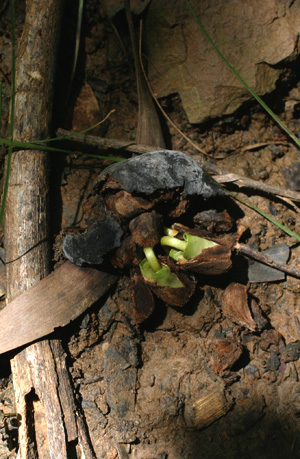
- INTRODUCTION
- RESTORATION
- PRINCIPALS
- Succession
- Seed Bank
What is the seed bank?
The seed bank is an important component of the plant community. Through the seed bank, the composition of the assemblage is maintained season after season. The plants we observe at any point in time are but the mortal and therefore temporary representatives of each species population, growing for the primary purpose of gathering the necessary energy and nutrients to produce seeds. Not that seeds are immortal; but they are designed to withstand a wider range of adverse conditions than the plant body. In the case of annuals, such as pōpolo, the seed will be the only part that survives through the dry season. And yet, year after year, we see pōpolo as a common constituent of our more open areas during approximately half of the year.
For most plants, their copious production of seeds ends up in the soil not far away. On the face of it, this is an excellent choice, since the soil and other conditions there have a proven record of suitability in the growth and survival of the parent. Of course, many plant species are specialized at widely dispersing their seeds and use a variety of mechanisms to accomplish this; another fascinating aspect of seeds outside our immediate interest.
• Milo seedlings (Thespesia populnea) germinating in the ripened fruit
Why are we concerned about the seed bank?
Seedlings that germinate close together enter a competition between "siblings" as well as with seedlings of other species in the seed bank (a process at the heart of natural selection). For example, milo grows to be a moderately large, spreading tree at Nā Pōhaku o Hauwahine and produces large numbers of round fruit throughout the year. These disperse by rolling away on slopes but mostly end up under the parent. Early in the wet season, hundreds of seedlings appear under the parent tree. Because of the deep shade there, these seedlings fail to thrive and gradually disappear during the following dry season. It is also the case that few plant species are able to survive in this shaded place, a fact we can use to our advantage.
The battle we wage to establish native plants and eliminate non-natives at Nā Pōhako o Hauwahine is essentially a battle for control of the seed bank. Removing alien plants through weeding is only a temporary "victory" as long as seeds of non-natives remain in the soil. With the next rainfall or certainly by the next wet season, the battle is rejoined—a fact often discouraging to hopes for success<2>. Consequently, we cannot measure progress by our clearing out weeds, but must observe and understand the patterns of seed distribution, seed longevity, and seed germination as these relate to the soil seed bank.
Measauring Success Reflected in the Seed Bank